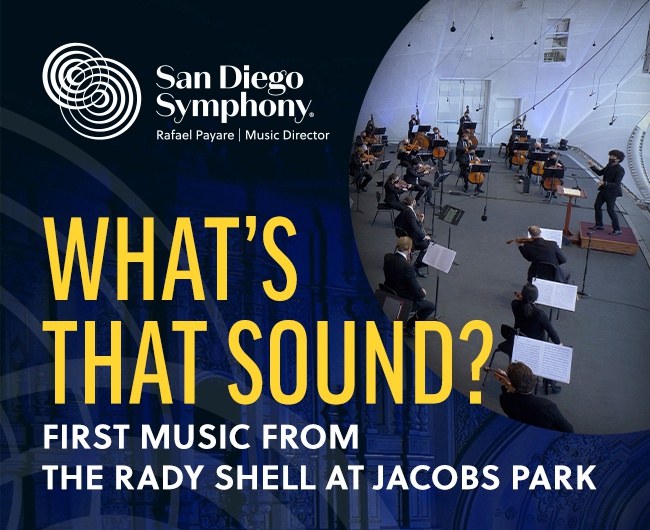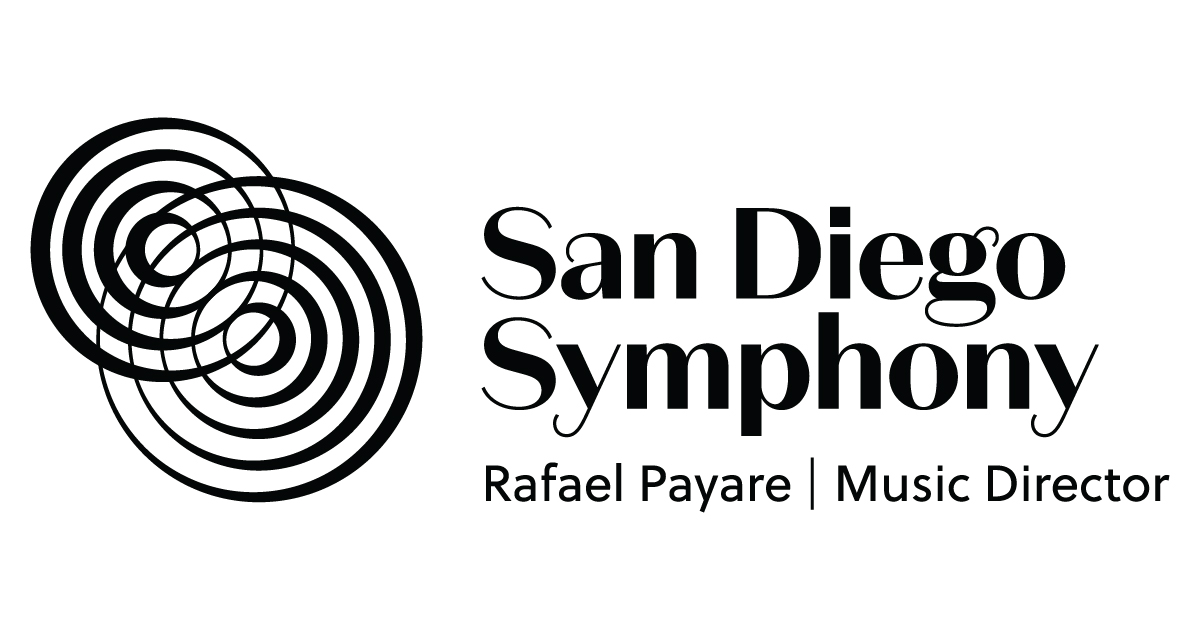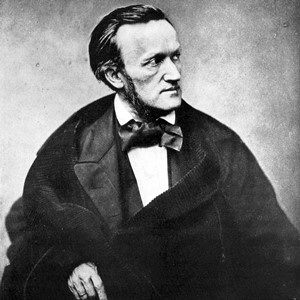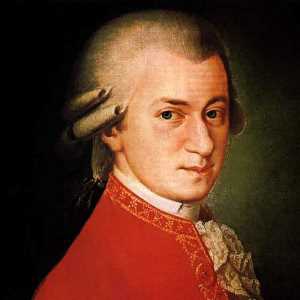
The long wait is over...Music has come to The Shell®!
"What's That Sound?": First Music from
The rady Shell® at jacobs park
STREAMS FRIDAY, MAY 21 @ 7PM PST!
We are thrilled to present the first San Diego Symphony concert to be recorded on the Una Davis Family Stage of The Rady Shell at Jacobs Park! For this very special occasion we have programmed one of our favorite composer "combos," Richard Wagner and Wolfgang Amadeus Mozart. The program, led by Music Director Rafael Payare, features some of the most heartfelt and joyous music ever created by either composer.
San Diego Symphony Orchestra
Rafael Payare, conductor
COMPLETE PROGRAM:
WAGNER: Siegfried Idyll
MOZART: Symphony No. 41 in C Major, K. 551, Jupiter
PROGRAM NOTES:
FROM THE HEIGHTS AND THE DEPTHS
This concert – the San Diego Symphony’s first concert from The Shell – brings us two of the most popular pieces of classical music ever written: Wagner’s glowing Siegfried Idyll and Mozart’s regal Jupiter Symphony. These two pieces are always on those lists radio stations compile of the Fifty Greatest Pieces Ever Composed, and deservedly so. Yet how utterly different were the circumstances of their creation! Wagner composed the Siegfried Idyll at a moment of overwhelming personal happiness. He wrote it as a Christmas gift to his wife Cosima and their son Siegfried, and he surprised her with its first performance. As she lay in bed on Christmas morning with the infant beside her, she suddenly heard this music performed on the stairway up to her bedroom by an orchestra of fifteen players, led by her husband. She would treasure this music for the rest of her life.
Mozart, however, wrote the Jupiter Symphony from the depths of despair. In the summer of 1788, the 32-year-old composer recognized that his music had gone out of fashion in Vienna. Audiences found it “too highly spiced,” and he could not put on new concerts because now no one was interested. His financial condition quickly worsened, and he began to borrow heavily. On June 27 he wrote to friend, asking for a loan and admitting that “black thoughts . . . often come to me, thoughts I push away with a tremendous effort.” Two days later, Mozart’s infant daughter Theresia died. Yet there is not the faintest trace of this personal calamity in his Jupiter Symphony, composed just a few weeks later. Mozart was too great an artist to let the events of his personal life shape his music, though to us it seems a miracle that this symphony – so powerful, so regal – should come from of a moment of such despair.
Two very popular pieces, both full of life. Yet they were written by composers at the far opposite extremes of the emotional spectrum.
Siegfried Idyll
RICHARD WAGNER (1813-83)
An understanding of Wagner’s lovely Siegfried Idyll requires some knowledge of that composer’s irregular personal life. In 1864, at the age of 51, Wagner began an affair with 27-year-old Cosima von Bülow, daughter of Franz Liszt and wife of pianist-conductor Hans von Bülow. Cosima bore Wagner three children before she moved in with him in 1868 and finally, in 1870 – after a six-year relationship and three children – the couple was married.
That fall, Cosima became aware that Wagner was working on a project he would not describe to her, and for good reason – it was to be one of the best surprises in the history of music. On Christmas morning, Cosima – asleep with eighteen-month-old Siegfried beside her – woke to the sound of music. Her husband had secretly composed and rehearsed a piece for small orchestra, and now that orchestra – arranged on the staircase leading to Cosima’s bedroom – gave this music its most unusual premiere. (It was also a little awkward – the doublebass player was around a corner and could not see Wagner conduct.)
Cosima treasured this music, which was full of private meanings for the couple. It is based on themes from Wagner’s as yet at the time unperformed opera Siegfried, but it also uses other themes with personal meaning for Wagner and Cosima. Cosima felt that the music was an embodiment of their life and love in these years, and when in 1878, pressed for cash, Wagner had the music published under the now-familiar title Siegfried Idyll, Cosima confessed in her diary: “My secret treasure is becoming common property; may the joy it will give mankind be commensurate with the sacrifice I am making.”
As good love music should be, Siegfried Idyll is gentle, warm and melodic. Listeners familiar with the opera Siegfried will recognize some of the themes, all associated with the young hero Siegfried: his horn call, the bird call from the Forest Murmurs sequence, and others. Wagner also quotes, in the oboe near the beginning, the old cradlesong “Sleep, Little Child, Sleep.”
Symphony No. 41 in C Major, K. 551, Jupiter
WOLFGANG AMADEUS MOZART (1756-91)
The summer of 1788 was an exceptionally difficult time for Mozart, but through those bleak months he worked with incredible speed: he finished the Symphony No. 39 on June 26, the Symphony No. 40 on July 25, and a bare sixteen days after that the Symphony No. 41. Why did he write these symphonies? Mozart usually wrote music only when performances were planned, but there is no record of any subscription concerts during this period. Perhaps such concerts were planned and then fell through, and Mozart – who died three years later – probably never heard his Jupiter Symphony. In fact, he would not have recognized that nickname. It was in use by the early nineteenth century, but its exact origin is unknown, and Mozart knew this music only as his Symphony in C Major. This is, however, one of those rare instances when an inauthentic nickname makes sense – if ever there was Olympian music, this is it.
The first movement – Allegro vivace – is music of genuine grandeur, built on a wealth of thematic material. The array of themes in this movement ranges from an almost military power to an elegant lyricism. The second movement is marked Andante cantabile, and this music sounds as if it might be an aria from an opera. First violins, muted throughout, introduce both themes of this sonata-form movement. The opening seems at first all silky lyricism, but Mozart jolts this peace with unexpected attacks. The third movement is in minuet-and-trio form, though no one has ever danced to this brisk music, whose fluid lines are spiced by attacks from brass and timpani. Its trio section is dominated by the sound of the solo oboe, though near its end strings break into a gentle little waltz that suddenly stops in mid-air.
The Molto allegro finale is not simply one of Mozart’s finest movements, it is one of the most impressive pieces of music ever written. This finale is not – as many have suggested – a fugue, but is instead a sonata-form movement that puts its opening four-note phrase through extensive fugal treatment. However dazzling Mozart’s treatment of his material may be in the course of the movement, nothing can prepare the listener for the coda. Horns sound the four-note opening motto, and in some of the most brilliant polyphonic writing to be found anywhere Mozart pulls all his themes together in magnificent five-part counterpoint as the symphony hurtles to its conclusion in a blaze of brass and timpani.
(Program notes by Eric Bromberger)




